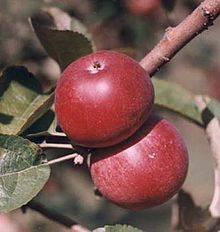Perry or pear cider is an alcoholic beverage made from fermented pears, traditionally in England, parts of South Wales, France, Canada, Australia, and New Zealand. There is growing interest in artisanal perry production in the fruit-growing regions of the northwest United States.

Cider apples are a group of apple cultivars grown for their use in the production of cider. Cider apples are distinguished from "cookers" and "eaters", or dessert apples, by their bitterness or dryness of flavour, qualities which make the fruit unpalatable but can be useful in cidermaking. Some apples are considered to occupy more than one category.

The Norfolk Biffin, also spelt Norfolk Beefing, is a local apple cultivar originating from the English county of Norfolk, also known by several other names including Reeds Baker, Tallesin, and Winter Coleman.
'Brown Snout' is a 19th-century cultivar of cider apple originating in Herefordshire in the United Kingdom, though now grown in other counties and parts of the world.

The Foxwhelp is a very old cider apple cultivar, originating in the west Midlands of England.

The Styre or Stire, also known as the Forest Styre, was an old English variety of cider apple which was formerly common in the Forest of Dean. It is currently thought to be extinct, but may still survive in old orchards or gardens.

The Redstreak, also spelt Redstrake, Red Streak or Red-streak, is or was a very old variety of cider apple formerly commonly planted in England.
The Hangdown, also known as Hangydown, Horner, or the Pocket Apple, is a traditional variety of cider apple grown mostly in Somerset and North Devon.

'Tom Putt' is a traditional variety of dual purpose apple, often used as a cider apple, originating in Devon. It was also known as Ploughman, Coalbrook, Marrowbone, Thomas Jeffreys and by many other local names.

Slack-ma-Girdle is an old variety of cider apple formerly widely grown in the South-West of England. It is one of a group of similar and closely related varieties all often known by the name "Woodbine".
Crimson King, also known as John Toucher's or the Bewley Down Pippin, is a traditional cider apple cultivar originating in Somerset.
Dufflin is an old variety of cider apple from the County of Cornwall, England. It was included in orchard trials by Long Ashton Research Station in 1957.

The Woodcock was one of the oldest described English varieties of cider apple. It originated in the West of England in the counties of Herefordshire and Gloucestershire.
Ellis Bitter, also called Ellis's Bitter or Ellis's Bitter-Sweet, is an English cider apple originating in Devon, but now widely planted across the west of England.
The 'Chisel Jersey' is a cultivar of cider apple originating in Somerset.
Michelin is a variety of cider apple commonly grown in commercial orchards in the United Kingdom, although originating in France.
The Coccagee, also spelt 'Cackagee' or 'Cockagee' and sometimes known as the 'Irish Crab' or 'Lord Cork's Crab', is or was a variety of cider apple, known in Ireland and the West of England.
Yarlington Mill is a traditional cider apple cultivar originating from the village of Yarlington, in the North Cadbury area of Somerset, England.
Major is a cider apple cultivar first grown in the United Kingdom in the area of Devon and Somerset.
Cap of Liberty, also known by the name Red Soldiers or Bloody Soldier, is a traditional cider apple cultivar originating in the Martock area of central Somerset.









